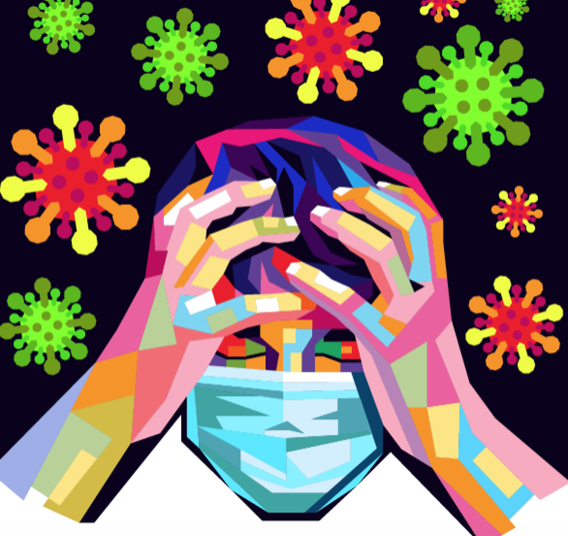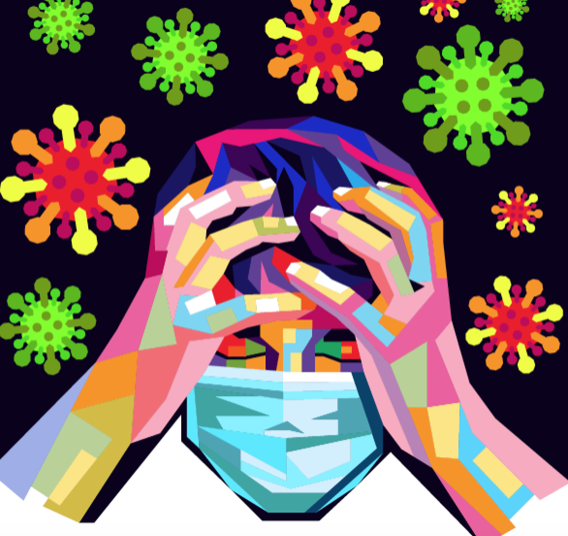Over a year into the worst global health crisis since 1918, student’s mental health is at a record low and therapy offices are shutting their doors in the faces of new clients.
America, as well as many other countries, has always had a severely underfunded mental health program, and now, the pandemic is exposing the extent of said underfunding. According to the National Alliance on Mental Illness (NAMI), “20.6% of U.S. adults experienced mental illness in 2019 (51.5 million people). This represents 1 in 5 adults.”
Now, according to Mental Health America, “The number of people screening with moderate to severe symptoms of depression and anxiety has continued to increase throughout 2020 and remains higher than rates prior to COVID-19.”
A year filled with isolation, uncertainty, and tragedy will take a toll on just about anyone’s mental health. The expectation that everyone should continue going to work and school virtually while watching the world shut down is harmful in itself, but to do so for a full year is simply unheard of. Humans are designed to socialize and interact with one another — we weren’t built to withstand conditions like these and with no clear end in sight, a mental health pandemic was bound to ensue.
Despite the growing need for long-term treatment for varying degrees of mental instability, mental health professionals remain inaccessible to the vast majority of people seeking treatment.
“I’ve had a hard time getting a physiatrist and finding private spaces to have therapy literally all of quarantine. I’ve left messages, met with doctors, and been turned down because they didn’t have space for me and I still don’t have a psychiatrist. They rarely get back to me and when they do, either my insurance doesn’t fully cover it or they don’t do telehealth and I’m not in their area,” SSU student Zero Carey said.
There are many ways the mental health industry has attempted to adapt to the world’s growing need, such as offering remote therapy, hotlines, and smartphone apps. For example, NAMI offers a helpline for anyone looking for free information about resources and treatment. NAMI is also a safe place for anyone struggling to cope in the moment, as they have trained employees ready to take calls and talk through any issues. Locally, there’s the Jewish Community Free Clinic in Santa Rosa, which offers free solution-based therapy and free counseling. For SSU students, Counseling and Psychological services offers free therapy appointments and has removed the cap on the number of visits each student is allotted, due to COVID-19. There are organizations like these all around the United States, and while they are a huge step in the right direction, they all provide more short-term, generalized counseling, compared to what a normal therapist’s office would.
On top of the fact that mental health professionals are currently inaccessible for first-time patients, the conditions for current patients is definitely not ideal to say the least. Due to COVID-19, therapy sessions have moved to Zoom for the last year, and for many patients, it just isn’t the same. There are clear issues with virtual therapy–such as, patients having trouble expressing vulnerability over the phone, a lack of accessibility to the internet, and issues with creating a secluded, safe space to share one’s innermost thoughts.
When asked about his experience with virtual therapy, Carey went on to say, “I’ve honestly given up and just dealt with the fact that my sessions are never truly private. I miss being in the office where I would cry a lot more because I felt more safe. I’ve cried once in my telehealth therapy sessions in the last year.”
There is also the issue of how these mental health facilities are deciding who to treat and who to turn away. The answer to the question “are you suicidal?” shouldn’t be the reason a person does or does not qualify for specialized, individual care, but due to the overwhelming demand for mental health services, this has become the standard practice.
Even before the pandemic, non-suicidal folks seeking help were asked the golden question and sent home with a bottle of overpriced medication that may or may not work. A person doesn’t need to be at their absolute breaking point to benefit from therapy, and to ask such a question in order to decide who gets the help they need is a direct insult to those asking for help.
SSU student Kay Aschwanden recounts a time in which they were turned away from an outpatient care center based solely on their lack of suicidal thoughts: “I was dismissed so quickly my heart dropped. I had to bite my lip to stop myself from crying in front of this woman who just invalidated me in so many ways by implying the only way I could get this level of care is if I told her specifically I was suicidal. She gave me one paper to the office of the psychiatrist I was already seeing, and I was back in my car.”
Mental health needs to be prioritized now more than ever, and while everyone continues to fight for a place in line, there are still options out there for those feeling hopeless. When professionals turn someone away, the best thing that person can do is turn around and keep self-advocating. Fighting for treatment, even after being turned away at every door, can help one practice self-advocacy when seeking psychological help. Self-advocacy is essential to the process of seeking help, and it will prove to be invaluable in obtaining the attention of tentative mental health professionals.
SSU senior Deja Whitney said, “In the beginning, finding a therapist felt impossible, but I never gave up. Just keep trying and it’ll happen. If you feel comfortable, reach out to friends or other professionals for help, and remember you don’t have to do it alone.”





![[Both photos courtesy of sonoma.edu]
Ming-Ting Mike Lee stepped in as the new SSU president following Sakakis resignation in July 2022](https://sonomastatestar.com/wp-content/uploads/2024/04/CC4520AB-22A7-41B2-9F6F-2A2D5F76A28C-1200x1200.jpeg)



























